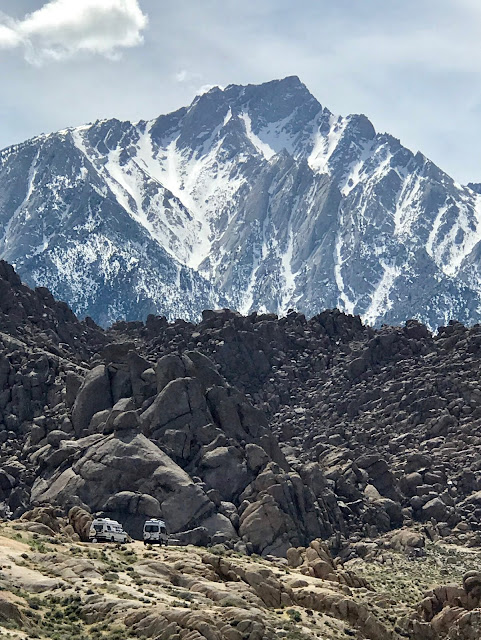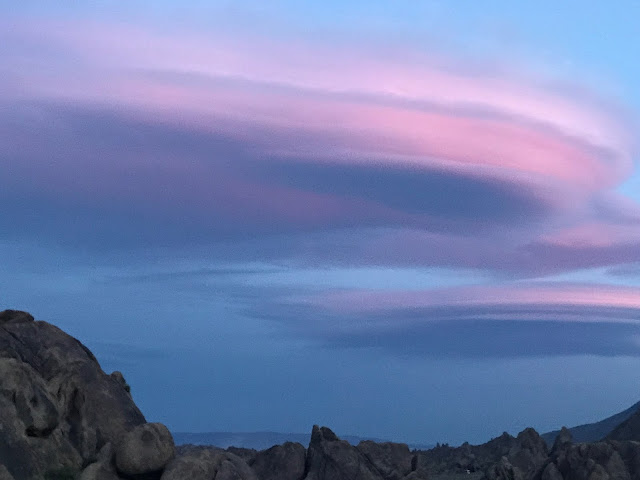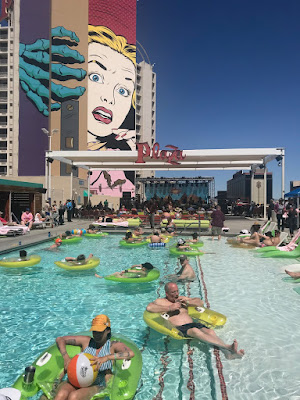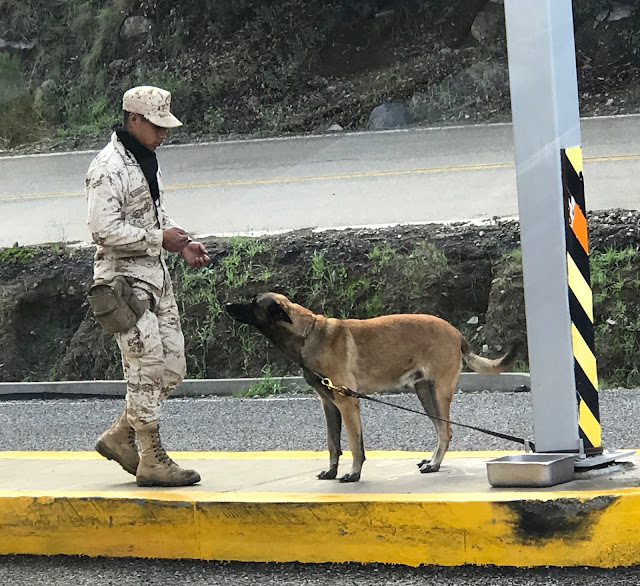 |
| The Alabama Hills at sunrise in March 2017. We didn't see quite this much glory in April 2019, but you can't go wrong with the Hills. |
We drove our fancy van in early April to a music event - the Bender Jamboree (bluegrass) at the Plaza Hotel in Las Vegas. Yes, Las Vegas. An absurd reality, perhaps the furthest possible place from the natural world.
Although we had an engaging four-day musical experience, the road trip from Southern Oregon to Las Vegas was rich with scenic routes and side trips. And, of course, a couple days in Reno to lavish love on the grands.
We were able to spend several of those scenic-routes and side-trips explorations with hometown friends Sue Orris and Ferron Mayfield, and their worried dog, Curry.
Yes, they brought Curry to Las Vegas, but it turned out OK, even though the dog was worried about staying in the van while his people were in a hotel a block away.
Maybe that was me who was worried. Anyway, the weather was cool and Curry was fine and very well attended. No worries!
Three places stand out: Alabama Hills near Lone Pine, CA, the Shoshone and Tecopa Hot Springs area bordering Death Valley, and Red Rock National Conservation Area about 17 miles west of Las Vegas, NV.
ALABAMA HILLS - Not to Be Missed
The Alabama Hills was our first stop after meeting up with Sue and Ferron in Bishop, CA on Hwy. 395, which cuts a pretty path alongside the scenic Sierras. Truly, if you haven't driven that road, add it to your plans. And do not miss the Alabama Hills. Even for a quick drive-through.
The Hills are just outside the town of Lone Pine, the western gateway to Death Valley National Park.
 |
| Our Class B vans are dwarfed (look for them) in a perfect camp spot in the Alabama Hills. |
Compared with nearby Death Valley's vast expanse, the Alabama Hills is a concentrated wonder. A jumble of giant buff-colored rocks is lorded over by the Sierra Nevada Mountains including 14,000 ft. Mt. Whitney. I used to think about climbing up there, but I got over that notion when, age-wise, I was already over the hill.
 |
| Lenticular clouds are common in the Alabama Hills. This dreamy color was fleeting during an otherwise dull sunset. |
If you've lived long enough, you've probably seen the Hills on the big screen. Over 150 movies (Some sources claim as many as 400 ) and numerous TV shows, mostly Westerns, were shot there in the days of Hopalong Cassidy, Gene Autry, and their ilk. A film museum in Lone Pine is said to be worth a visit. We will get there next time.
 |
| Responsible campers carry it out. |
Campsite hunting is competitive, with tent campers, small trailers, and Class B and C RVs seeking the perfect place to settle in and enjoy the splendid views all around.
 |
| Sue and Ferron were in their element. Mt. Whitney is circled. The Mobius Arch Trail begins behind us. |
 |
| The loop trail to the arch is about a mile long. |
 |
| Ferron exults at the Mobius Arch. A sprite-like person, Ferron usually doesn't travel without a kite, a blaring horn, or his dog. I was pleased that he left the horn behind. |
DEATH VALLEY - Blown away
 |
| Death Valley, where we had camping reservations for two nights, was devoid of spring blooms and spring crowds. Due to the unrelenting wind and dust, it was soon devoid of us. |
Serendipity at SHOSHONE and TECOPA
Thus we took an unplanned one day/night side trip to the Tecopa Hot Springs. Our experiences there hung me up for days in getting this post out.
Honestly, the Shoshone/Tecopa hot springs area just outside Death Valley is such a quirky bit of Wild West Americana that I got all twisted about it. I wrote pages. None of them any good!

I've decided not to tackle it. There's too much to tell and way more to learn before I pretend to capture the spirit of this unusual place. We were there for fewer than 24 hours.
It's worth a return trip and perhaps a few days .... or more. But I'd better be careful.
Seems that numerous people living in the area had been just passing through.....and the place took hold of them. On the surface, it's dry, dusty and decrepit with scant visual charm. But there's something juicy going on there.
If you're traveling from Death Valley to Las Vegas, discover Shoshone/Tecopa for yourself. Be sure to visit the museum in Shoshone, where, if lucky, you'll be greeted by John.
A former big-city chef, John is eager to share info about a place he loves. After living in Tecopa for 13 years, he knows everything tourist.
 |
Curry contemplates as he walks the labyrinth at the Tecopa Hot Springs Resort. What is life's meaning? Why is my tongue so long? He's quite the philosopher, that dog.
|
 |
| Typical Tecopa scene. Curry leads Ferron in exploration. Soon we reluctantly leave Tecopa. At least I was reluctant. |
RED ROCK CANYON National Conservation Area - Great side trip from Las Vegas
In Nevada's Mojave Desert, Red Rock Canyon's primary attraction, aside from an excellent Visitor's Center, is a 13-mile scenic loop drive with numerous viewpoints and parking areas from which to hike, picnic, photograph, rock climb, or otherwise take pleasure in this beautiful place.
 |
| Here's the not-red-rock part of the conservation area, but even if not red, it is imposing, dramatic, beautiful. |
 |
| Cairns for Dummies is what we called the numerous (thank you) extravagant (thank you) trail markers. Without them, we might still be there. |
 |
| Is it an agave? Curry is weighing in from a lower position. Or maybe that's his power position. |
 Sue was still recovering from knee surgery, so we chose a relatively short hike through the red rocks. See that cairn?
Sue was still recovering from knee surgery, so we chose a relatively short hike through the red rocks. See that cairn? Without it, we would not have chosen this skinny passage.
Then, I'm afraid, it was on to Las Vegas and the Plaza Hotel and wrapping our heads around living in a casino the next four days.
But then, there was the
🎶MUSIC! 🎶
BENDER JAMBOREE -whoopee!
 |
| This is Billy Strings. Never heard of him? Neither had I, but the virtuoso guitarist/singer was my favorite. Apparently, he's getting around. Check him out. |
Other artists to join my "listen" list:
- Railroad Earth (not new to the list, but the primary reason we attended the Jamboree)
- Della Mae - all female. Kicked butt!
- Leftover Salmon
- The Hillbenders
- The Good Time Travelers
- Keller Williams Pettygrass (all Tom Petty covers)
 |
| Della Mae's band stood out amidst a mostly male lineup. Not just for being women, but for being good! |
 |
| Ferron always brings a cute outfit. |
 |
| On our way home to Oregon, we camped alone at a reservoir near Fallon, NV. Ahhh. Just what we needed. |
Previous Posts
SW Road Trip Spring 2017
Death Valley 1, Super Bloom
Death Valley 2
A couple of posts about our winter Baja trip are below. A few more to come. Unless I decide to write about gardens and food for a while.
An Inglorious Day on the Road in Baja
On the Road in Baja - Part 1





































